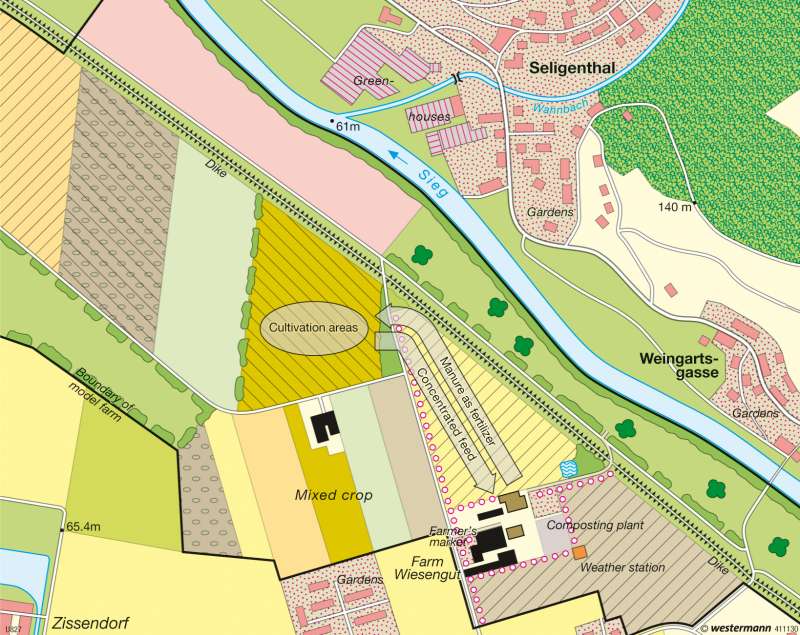Wiesengut Hennef (Germany) — Organic farming
Europe - Agriculture
978-3-14-100790-9 | Page 47 | Ill. 2

Information
In past decades, in conventional agriculture, a high degree of specialized intensity in thoroughly rationalized farming operations and an extensive separation between arable farming and animal husbandry have taken place. In the course of this development, many one-sided market fruit producing or finishing operations have come into existence. Aspects such as protection of nature and the environment, on the other hand, have long been neglected in conventional farming. In contrast to this, organic farming works according to the organisational principle of a largely self-contained farming organism. This means that, in organic agriculture, mixed farm operations are dominant. The farm is, as it were, adapted "organically" to the ecological circumstances of the locality in question. This adaptation, and the corresponding management appropriate to the location, have an individual character and are determined on a local basis.Principles of Organic Farming
Organic farming is based on the maxims of preserving non-renewable energy and raw material resources, preserving the functioning of the ecosystem, and protecting nature and the landscape in the production of foodstuffs. Land use at the Wiesengut model farm shows how organic farming shapes the landscape in observance of these principles.
In the production biotope, the arable areas are occupied by a six-field, six-year crop rotation consisting of red clover grass, potatoes, winter wheat, field beans, summer wheat and winter rye. Cattle husbandry and the growing of red clover grass as fodder favour this multiform rotation. With the use of undersowing, for example of clover grass in winter rye or mustard/radishes in potatoes, and with catch crops such as mustard or radishes, an almost complete all-year-round ground coverage with growing cultivated plant stock is achieved. At the same time the seepage of nutrients into the groundwater is minimized.
Farms operating organically dispense with the use of mineral nitrogen fertilizers, growth regulators and chemical-synthetic pesticides; they also minimize the buying-in of animal feed. Excesses of nutrients and environmentally damaging seepage of materials into the groundwater are thus largely avoided or at least substantially reduced. This advantage of organic farming benefits especially the sensitive areas of drinking water production and the protection of nature and the landscape.
Impact on the Landscape
Appropriate animal husbandry methods require the daily pasturing of the animals (in summer), and thus affect both land use and the appearance of the landscape. Groups of trees planted in the pastures serve as shade for the young cattle. Generous exclosures secure the wide, tree-grown boundary zones.
Ecologically-relevant landscape elements of the accompanying biotope contribute in many ways to the shaping of the landscape, and also in recreation areas in the neighbourhood of cities:
— Linear structural elements such as hedges, mainly planted in a north-south direction, minimize shade to the cultivated plant stock and serve as barriers against westerly winds. The richly flourishing copses are accompanied by species-rich, blossoming margins that support beneficial species.
— Field ends are left uncultivated, and as ruderal sites these represent a place of refuge for small game such as pheasant.
— Broad balks along the ways, a rich flora of wild flowers in the field areas and purposely-sown strips of flowers serve as habitats.
— Roof run-off water finds its way into a damp biotope instead of the municipal sewage works.
— In the neighbourhood of the farm, orchards and wild fruit hedges provide shade and a favourable microclimate; they serve at the same time as a refuge for birds, make the farm attractive for direct on-farm sales customers, and have a positive effect on the appearance of the landscape.
Thus, organic farming goes beyond its primary aim of producing high-quality food, in that it represents in exemplary fashion how the multifunctionality of agriculture shapes the landscape. It thus meets in a special way, as has been scientifically proved in ecological balance sheets and comparative studies, the principles of sustainable and environment-friendly agriculture.
Outlook
In spite of the strongly growing demand in food retailing and discount chains, the market for organic products is still relatively small, resulting in higher acquisition, processing and distribution costs. As a consequence, organic products often have a higher price than comparable products from conventional production.
But in the past the switch to organic farming has nevertheless proved to be an economically worthwhile alternative for the majority of farms that have converted. In recent years the profit generated was significantly higher than that obtained from comparable, conventionally-operated farms.
Due to their role in the protection of nature and the landscape and their significance for the provision of jobs in rural areas, organically-operating farms receive subsidies for the introduction and maintenance of ecological management methods. In 2007, for example, this was 187 or 137 euros per hectare of farmland. The somewhat higher direct payments from the state in comparison to conventional agriculture are the result of the above-mentioned payments for environmental measures in farming.
U. Köpke, H. Nieberg; Ü: J. Attfield




